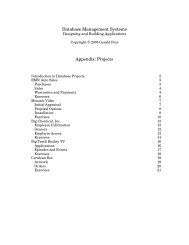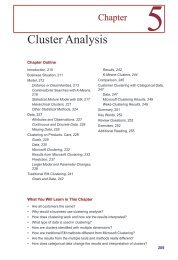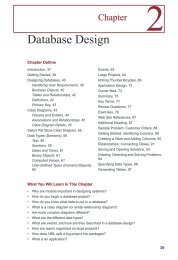Revision History - Jerry Post
Revision History - Jerry Post
Revision History - Jerry Post
You also want an ePaper? Increase the reach of your titles
YUMPU automatically turns print PDFs into web optimized ePapers that Google loves.
Several other corporate employees lasted a year or less. In the field, experienced<br />
managers were routinely sacked to cut costs. Most of the terminals were staffed with parttime<br />
workers and “customer-service associates.” These employees earned $6 an hour regardless<br />
of their jobs, with little or no chance for a raise. Few of them had completed high<br />
school. Turnover at some terminals ran 100 percent a year and 30 percent was common.<br />
Ralph Borland, a long-time Greyhound manager working as vice-president for customer<br />
satisfaction, notes that the turnover rate did not bother Greyhound management, since “If<br />
people stayed around too long, they would get too sour and cynical.”<br />
When touring facilities, customer-service executives were “shocked” to find terminal<br />
workers making fun of customers and ignoring others. Ridership was falling. To cut costs<br />
further, the number of buses and drivers was cut (down by half since the mid-1980s) and<br />
routes were rescheduled. Bus drivers began complaining that they had to exceed speed limits<br />
to meet the new schedules.<br />
Financial Performance<br />
Revenue and Net Income (Million $)<br />
Year 12/31/2003 12/31/2002 12/31/2001 12/31/2000 12/31/1999 12/31/1998<br />
Passenger 830.6 849.8 876.9 861.8 783.3 727.8<br />
Package 39.5 40.0 41.2 42.4 41.5 36.2<br />
Food 39.7 42.2 43.7 43.0 39.1 31.1<br />
Other 65.7 60.0 60.6 67.0 62.1 53.3<br />
Total 975.5 991.9 1,022.4 1,014.3 926.0 848.4<br />
Net Income (28.9) (111.6) 2.0 12.6 (16.3) 35.2<br />
Balance Sheet (Million $)<br />
Year 2003 2002 2001 2000 1999<br />
Current Assets 81.7 74.6 110.8 96.9 87.6<br />
Long term Assets 456.5 486.8 577.6 581.2 564.5<br />
Total Assets 538.2 561.3 688.5 138.2 175.3<br />
Current Liabilities 140.5 153.4 126.3 138.2 175.3<br />
Long term Liabilities 469.4 521.4 374.2 302.1 206.9<br />
Total Liabilities 609.9 674.8 500.5 440.3 382.2<br />
Stockholder Equity/Deficit (71.7) (113.5) 187.9 235.2 227.9<br />
The problems at Greyhound are reflected in its financial performance. Obviously,<br />
the company had problems when it declared bankruptcy. The company improved in the<br />
mid- to late-1990s, but passenger revenue peaked in 2001 [annual reports]. Even more<br />
amazing, check out the stockholder equity in 2002 and 2003. It is negative! How long can a<br />
company survive when its liabilities exceed its assets?<br />
In 1999, Greyhound was acquired by Laidlaw, a Canadian company that owns a diverse<br />
collection of transportation firms. In June 2001, Laidlaw filed bankruptcy in the<br />
United States and in Canada. Two years later, in June 2003, Laidlaw emerged from bankruptcy<br />
protection [2003 annual report]. In response to this parent-company bankruptcy,<br />
Greyhound effectively became more financially independent. In 2000, already facing problems,<br />
Laidlaw cutoff funding [Heinzl 2000]. Within a couple of months, Greyhound secured<br />
20







